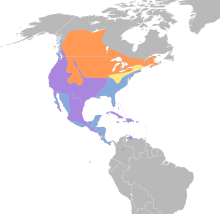| American coot | |
|---|---|

| |
| American coot in New York City | |
| Scientific classification | |
| Domain: | Eukaryota |
| Kingdom: | Animalia |
| Phylum: | Chordata |
| Class: | Aves |
| Order: | Gruiformes |
| Family: | Rallidae |
| Genus: | Fulica |
| Species: | F. americana
|
| Binomial name | |
| Fulica americana Gmelin, JF, 1789
| |

| |
Breeding range Winter-only range Year-round range Passage
| |
| Synonyms | |
and see text | |
The American coot (Fulica americana), also known as a mud hen or pouldeau, is a bird of the family Rallidae. Though commonly mistaken for ducks, American coots are only distantly related to ducks, belonging to a separate order. Unlike the webbed feet of ducks, coots have broad, lobed scales on their lower legs and toes that fold back with each step to facilitate walking on dry land.[2] Coots live near water, typically inhabiting wetlands and open water bodies in North America. Groups of coots are called covers[3] or rafts.[2] The oldest known coot lived to be 22 years old.[2]
The American coot is a migratory bird that occupies most of North America. It lives in the Pacific and southwestern United States and Mexico year-round and occupies more northeastern regions during the summer breeding season. In the winter they can be found as far south as Panama.[2] Coots generally build floating nests and lay 8–12 eggs per clutch.[2] Females and males have similar appearances, but they can be distinguished during aggressive displays by the larger ruff (head plumage) on the male.[4] American coots eat primarily algae and other aquatic plants but also animals (both vertebrates and invertebrates) when available.[5]
The American coot is closely related to the Eurasian coot (Fulica atra), which occupies the same ecological niche in Eurasia and Australia as the American coot does in North America.[citation needed] Eurasian coots can be distinguished from this species by the absence of a red callus above the bird's frontal shield.[citation needed]
The American coot is listed as “Least Concern” under the IUCN conservation ratings.[1] Hunters generally avoid killing American coots because their meat is not as sought after as that of ducks.[2]
American coots display several interesting breeding habits; mothers will preferentially feed offspring with the brightest plume feathers, which has resulted in coot chicks having brightly ornamented plumage which becomes drabber as they age.[6][7] American coots are also susceptible to conspecific brood parasitism and have evolved mechanisms to differentiate their offspring from those of parasitic females.[8]
- ^ a b BirdLife International. (2016). "Fulica americana". IUCN Red List of Threatened Species. 2016: e.T62169677A95190980. doi:10.2305/IUCN.UK.2016-3.RLTS.T62169677A95190980.en.
- ^ a b c d e f Cite error: The named reference
Cornellwas invoked but never defined (see the help page). - ^ Group Names for Birds, Baltimore Bird Club
- ^ Gullion, Gordon W. (1952). "The Displays and Calls of the American Coot". The Wilson Bulletin. 64 (2): 83–97. JSTOR 4158081.
- ^ Cite error: The named reference
Hoyowas invoked but never defined (see the help page). - ^ Stephens, Tim (30 December 2019). "The mysterious case of the ornamented coot chicks has a surprising explanation". UC Santa Cruz.
- ^ Davies, Nicholas B.; Krebs, John R.; West, Stuart A. (2012). "8". Behavioural Ecology. West Sussex, UK: John Wiley and Sons. ISBN 9781405114165.
- ^ Cite error: The named reference
Shizuka 2009 223–226was invoked but never defined (see the help page).
